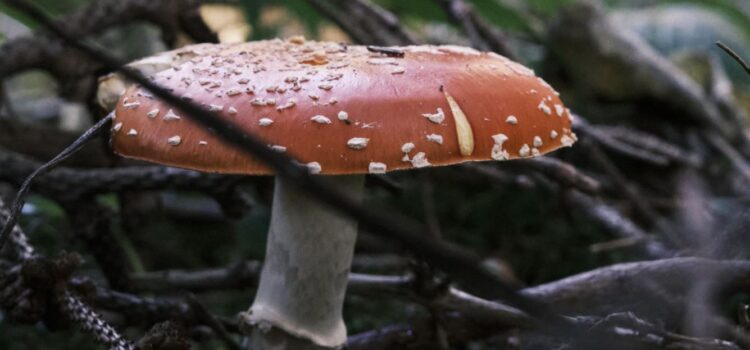

This article is an excerpt from the Shortform book guide to "Entangled Life" by Merlin Sheldrake. Shortform has the world's best summaries and analyses of books you should be reading.
Like this article? Sign up for a free trial here.
How do fungi grow? What are the two types of fungal growth?
All organisms grow cells and larger structures according to genetic instructions. Entangled Life by Merlin Sheldrake examines the overall process of fungal growth, including the two types of growth: branching and fusing.
Keep reading to learn what we know about fungal growth and the mysteries that still remain.
The Process of Fungal Growth
How do fungi grow? According to Sheldrake, multicellular fungi grow by lengthening their hyphal tips—the ends of their mycelia. By contrast, most other multicellular organisms grow by building layers of cells, like a 3-D printer. (Shortform note: Some organisms grow using an approach that resembles fungi’s lengthening approach and other organisms’ layering approach. For instance, a type of bacteria found in caves forms chains of cells (similar to hyphae), then it folds these chains into a three-dimensional structure that resembles a tangled mass of yarn.)
Furthermore, Sheldrake elaborates that fungal growth is both fast and forceful. Let’s further explore these two ideas.
Fungal growth is fast: Small packets containing the materials for cell growth travel through a fungus’s mycelium, arrive at a hyphal tip, and add new cells to the chain—at a rate of over five hundred packets per second. (Shortform note: Sheldrake claims that the fungal growth process is fast, but he doesn’t provide a basis for comparison. Other sources clarify that fungi can grow at a rate of around 1.2 millimeters per hour—a growth rate significantly higher than those of most other organisms.)
Fungal growth is forceful: Fungi eat by digesting organic matter in their surroundings, so they need a method for inserting themselves into this matter. They use specialized hyphae that build up a high internal pressure so they can bust through cell walls. (Shortform note: Research suggests that pressure isn’t the only way fungi enter matter. Some fungi form protrusions that worm their way into matter using a wiggling motion.)
Two Types of Fungal Growth: Branching and Merging
According to Sheldrake, when hyphae lengthen, they either branch into new territory or fuse with the fungus’s existing mycelium. Let’s further explore both types of fungal growth.
Branching: Sheldrake explains that mycelia branch radially from a spore (a fungi’s first cell). This radial branching allows a mycelium to expand into vast territories. (Shortform note: Although most fungi’s radial branching is underground, you can sometimes see evidence of it above ground in the form of “fairy rings”—circles of mushrooms. Fairy rings begin forming when a mycelium expands at a uniform rate from its underground spore. Then, when the conditions are ideal for mushroom growth, the mycelium’s hyphae grow upward and develop mushrooms.)
Fusing: Whereas branching is all about expanding a fungi’s territory outward, fusing is about creating a density of connections within a mycelium. When one hyphal strand fuses with another, it creates a shortcut, allowing materials (such as water and nutrients) and chemical signals (which we’ll explore later) to travel rapidly from one part of a fungus to another part.
(Shortform note: Recent research reveals that fungi survive harsh environments by controlling the rate at which their hyphae fuse. A molecule found in some fungi increases hyphal fusion when those fungi face extreme temperatures. This uptick in fusion makes a fungus’s mycelial network more interconnected, allowing it to rapidly send stress signals that help the fungi adapt to extreme temperatures.)
What We Still Don’t Know
According to Sheldrake, many aspects of fungal growth remain a mystery. For instance, how do fungi organize their hyphae to become mushrooms? This question remains unanswered because an organism’s organization determines its growth, and fungal organization is unlike that of any other organism. Fungi form structures such as mushrooms using one type of cell—hyphal cells—whereas non-fungi form structures using multiple types of cells. Therefore, scientists have to develop new methods and models for understanding fungi growth.
(Shortform note: Why is this mystery worth solving? According to experts, research on mushroom formation may help us cultivate mushrooms that currently only grow in the wild. Knowing what mechanisms and conditions promote mushroom growth could make it easier to reproduce those conditions on fungi farms. As we’ll explore later, mushrooms have many uses, and increasing cultivation means improving our ability to solve problems using fungi.)

———End of Preview———
Like what you just read? Read the rest of the world's best book summary and analysis of Merlin Sheldrake's "Entangled Life" at Shortform.
Here's what you'll find in our full Entangled Life summary:
- An examination of what we know and don't know about fungi
- How fungi can help solve many modern-day problems
- The three most important benefits of fungi






